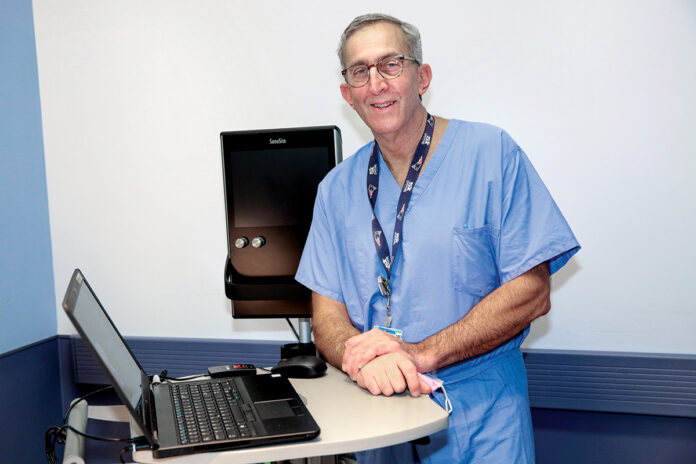
Thirty years ago, when Dr. John Froehlich was an orthopedic surgical resident, the average stay for patients coming into hospitals for replacement of knees and hips was seven days. By 2011, when the Total Joint Center opened at The Miriam Hospital, its typical patient remained in the hospital for almost four days.
Last year, thanks to greater efficiencies and a coordinated effort among health care professionals, the center led by Froehlich reduced its average hospital stay to one day – a statistic that reflects the speed of people getting back on their feet after surgery, but also an increase in outpatient procedures.
About 250 people in the last six months have had knees, hips or shoulders replaced through an outpatient process at the Total Joint Center at Miriam or other clinical settings used by its team of surgeons, he said.
That’s a small but growing portion of the Total Joint Center’s volume. It had 1,405 patients last year.
How has joint replacement become an outpatient procedure? Several factors have combined to make it a preferred option for patients, said Froehlich, Total Joint Center director and a board-certified orthopedic surgeon. He is one of the founding members of University Orthopedics Inc.
First, the surgical techniques used in joint replacement have improved, as well as pain management. For example, physicians can use specific steroids to block pain in a joint area.
‘The most important thing is that it be done safely.’
DR. JOHN FROEHLICH, The Miriam Hospital’s Total Joint Center director
In addition, the team at the Total Joint Center follows a consistent, deliberate approach to the patient experience in the hospital and after they are discharged, which has led to more coordinated care.
People are not sent home alone. They are met in the driveway with a visiting nurse, who gets them settled, and physical therapy begins soon after. The result is lower costs for the procedures and faster recovery, Froehlich said.
In the past six months, only two patients who received the outpatient procedure at Miriam had to be readmitted for reasons that were not directly related to the orthopedic surgery, Froehlich said.
“Certainly it’s great that patients can go directly home,” Froehlich said. “The other is it’s a substantial savings for the health care system. For every 1% decline in [skilled nursing facility] utilization, that saves $23,000 on average for a patient.”
Over the volume of patients seen annually, that’s more than $1 million in savings in the Rhode Island health care system, he said – either in out-of-pocket savings for patients or reduced expenses for insurers.
Patients likely to be recommended for home recovery are in good physical condition, have no underlying medical conditions such as high blood pressure, and have someone at home who can help them.
Their home is a consideration. Someone who lives in a ground-level or second-level condo may be a better fit than a person who has to climb multiple flights of stairs.
Marilyn Nalibow, an East Greenwich resident, had her left knee replaced on Dec. 24 through an outpatient procedure. Her surgeon was Dr. Eric Cohen, who is part of the Total Joint Center group.
She asked for the outpatient procedure. “I had heard this was possible. I was reluctant to be in the hospital. I was concerned about COVID-19. I just felt I would recover and be much better at home,” Nalibow said.
Her surgery proceeded smoothly. But she was comforted knowing that she was having the procedure done in a hospital, where if she needed more care, it would be right there.
“My surgery was at 7:30 in the morning and I was ready to go home at 2 o’clock,” Nalibow said. She had the proper medications and didn’t feel groggy or ill, she said.
To prepare, Nalibow went through three months of “pre-hab,” strengthening her muscles and preparing for the surgery with a physical therapist. She also credits her good physical condition with her outcome. Six weeks after the surgery, Nalibow, 77, feels less pain and is moving better. Before the surgery, she had suffered from arthritis in her knees and had tried all nonsurgical alternatives.
“It was a last resort, but it was very successful,” she said.
The Total Joint Center uses a predictive tool to assess who is a good candidate, Froehlich said.
For the health care team, outpatient surgery requires coordination of services at the patient’s home, including nursing and physical therapy visits. The possibility of infection, always a risk after surgery, is monitored by these in-home professionals.
The Total Joint Center, Froehlich said, has infection and 30-day hospital readmission rates well below the guidelines set by the federal Centers for Medicare & Medicaid Services.
“The most important thing is that it be done safely,” he said.
Word-of-mouth among patients is one of the reasons why its numbers have grown, he said.
In the recent past, people avoided having major joints replaced because they’d heard from older relatives how painful it had been. In recent years, word-of-mouth has shifted.
“The best advertising we have is our patient outcomes,” he said.
Mary MacDonald is a PBN staff writer. Contact her at Macdonald@PBN.com.












